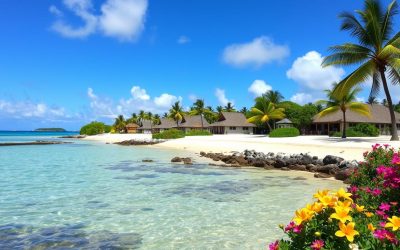✓ Accommodations ✓ Flights ✓ Rental Cars
Planning a trip to Nauru requires understanding its unique climate patterns to make the most of your visit.
As one of the world’s smallest independent republics, Nauru offers a distinctive travel experience heavily influenced by its tropical maritime climate.
The weather significantly impacts your enjoyment of Nauru’s pristine beaches and natural attractions. This guide will help you identify the optimal time for your visit based on temperature, rainfall, and humidity.
By understanding the island’s climate patterns, you can plan a weather-savvy trip that aligns with your preferences and activities, ensuring a memorable travel experience.
Understanding Nauru’s Unique Island Climate
Understanding Nauru’s climate requires a look into its geographical attributes and how they impact weather patterns. Nauru, a small island nation in the Pacific, is characterized by its tropical climate and minimal seasonal variations.
Geographic Location and Its Impact on Weather
Nauru’s geographic location significantly influences its weather. The island’s proximity to the equator ensures consistently warm temperatures throughout the year. With little seasonal variation in daily highs and lows, Nauru’s climate is relatively stable in terms of temperature.
Year-Round Climate Characteristics
Nauru experiences two primary seasons: a drier period from May to November and a wetter period from December to April. The humidity remains high year-round, typically above 70%. The climate is also marked by persistent cloud cover, with clearer skies during the drier season.
| Season | Months | Characteristics |
|---|---|---|
| Drier Season | May – November | Less rainfall, clearer skies |
| Wetter Season | December – April | More rainfall, higher humidity |
By understanding these climate characteristics, you can better plan your trip to Nauru, making the most of the year-round warm weather.
Temperature Patterns Throughout the Year
Nauru’s temperature remains remarkably consistent throughout the year, making it an ideal destination for travelers who prefer predictable weather. This consistency is a result of several geographical and climatic factors.

Average Monthly Temperatures
The average monthly temperatures in Nauru show minimal variation, with the temperature ranging from 86°F to 88°F (30°C to 31°C) throughout the year. This narrow range means that the temperatures are always warm, making it suitable for various outdoor activities year-round.
Minimal Temperature Variations Explained
Several factors contribute to Nauru’s stable temperature pattern. The island’s proximity to the equator results in nearly equal day length throughout the year, leading to consistent solar heating. Additionally, the surrounding Pacific Ocean acts as a massive heat sink, absorbing and releasing heat slowly, which prevents rapid temperature changes on the island. As a result, daily temperature ranges are typically just 2-3°F (1-2°C), much narrower than in continental locations.
The consistent temperature pattern means you can pack similar clothing regardless of when you visit Nauru. Lightweight, breathable fabrics are recommended year-round due to the warm and stable climate.
Rainfall and Precipitation Cycles
The island of Nauru experiences a unique rainfall pattern throughout the year. Understanding these patterns is essential for travelers to make the most of their trip.
Wet Season vs. Dry Season
Nauru’s wet season typically runs from December to February, with the highest rainfall averages occurring during these months. In contrast, the dry season, which spans from May to September, sees significantly less precipitation. The transition periods, March to April and October to November, show gradual changes in rainfall averages.
- Peak Wet Season: December through February, with monthly rainfall averages of 6.3-7.0 inches.
- Transition to Dry: March and April, with averages of 5.4-5.7 inches.
- Dry Season: May through September, with rainfall ranging from 3.3-3.8 inches.
- Transition to Wet: October and November, with averages of 4.2-5.0 inches.
Monthly Rainfall Averages
Here’s a breakdown of the average monthly rainfall in Nauru: January (6.5″), February (6.3″), March (5.7″), April (5.4″), May (3.5″), June (3.3″), July (3.8″), August (3.7″), September (3.4″), October (4.2″), November (5.0″), and December (7.0″). The rainfall tends to fall in short, intense bursts, allowing for outdoor activities even during wetter months.
Humidity and Comfort Levels by Month
When planning your trip to Nauru, understanding the humidity levels can make a big difference in your travel experience. The island’s humidity varies throughout the year, affecting your comfort during outdoor activities.
Understanding Nauru’s High Humidity
Nauru is known for its high humidity levels throughout the year. The relative humidity often averages above 70%, making it feel warm and muggy. High humidity can impact your comfort during outdoor activities, so it’s essential to plan accordingly.

When Humidity Feels Most Comfortable
The period from June through September typically offers the most comfortable humidity conditions in Nauru, coinciding with the heart of the dry season. During these months, slightly lower relative humidity (averaging 70-75%) combines with consistent trade winds to create a more pleasant outdoor experience. You can enjoy outdoor activities like exploring the island or simply taking a stroll along the beach during this time.
To make the most of your trip, consider visiting during the best time to visit, which is from mid-July to mid-November, with a peak score in the first week of September. This period allows you to enjoy the island’s beauty while feeling relatively comfortable.
Wind Patterns and Ocean Conditions
As you plan your trip to Nauru, understanding the wind patterns and ocean conditions is crucial for making the most of your visit. The island’s unique geography and location in the Pacific Ocean influence its wind and ocean conditions, making it a fascinating destination for travelers.
Seasonal Wind Variations
Nauru experiences varying wind patterns throughout the year. While the winds are generally moderate, there are seasonal changes that you should be aware of to plan your activities accordingly.
Water Temperature Throughout the Year
The water temperature around Nauru remains remarkably consistent, ranging from 84°F to 85°F (29°C to 29.5°C) throughout the year. Here is a breakdown of the average water temperature by month:
| Month | Water Temperature |
|---|---|
| Jan | 84°F |
| Feb | 84°F |
| Mar | 84°F |
| Apr | 84°F |
| May | 84°F |
| Jun | 85°F |
| Jul | 85°F |
| Aug | 85°F |
| Sep | 85°F |
| Oct | 85°F |
| Nov | 85°F |
| Dec | 84°F |
The warmest water temperatures are typically observed from June to November, with an average of 85°F (29.5°C), while the period from December to May sees slightly cooler temperatures at around 84°F (29°C). This consistent warmth makes Nauru an ideal destination for swimming and water activities throughout the year.
Cloud Cover and Sunshine Hours
The amount of cloud cover and sunshine in Nauru changes throughout the year, affecting your day-to-day activities during your travel. Understanding these patterns can help you plan your trip more effectively.
Clearest Months for Blue Skies
Nauru experiences its cloudiest month in January, with the sky being overcast or mostly cloudy 81% of the time. In contrast, the period between May and October offers the clearest skies, making these months ideal for activities that require clear weather.
| Month | Cloud Cover |
|---|---|
| January | 81% |
| May | 40% |
| October | 45% |
Impact on Photography and Sightseeing
Cloud patterns significantly impact photography conditions in Nauru. The “golden hours” shortly after sunrise and before sunset provide the most dramatic lighting for photography, particularly during the clearer months. For visitors interested in stargazing or astrophotography, August and September offer the best combination of clear night skies and comfortable evening temperatures. You can plan your sightseeing activities during this time to make the most of your travel to Nauru.

Nauru: Best Months for a Weather-Savvy Trip
When planning your trip to Nauru, understanding the best time to visit is crucial for a weather-savvy journey. The island’s climate varies significantly throughout the year, making some months more suitable for travel than others.
May to November: The Optimal Weather Window
From May to November, Nauru experiences its dry season, characterized by less precipitation and more favorable weather conditions. During these months, you can expect clearer skies and more comfortable temperatures, making it an ideal period for outdoor activities and sightseeing.
December to April: What to Expect
The period from December to April marks Nauru’s wet season, with increased precipitation and cloud cover. January is typically the cloudiest month, with the sky being overcast or mostly cloudy about 81% of the days. You can expect 12-15 rainy days per month from January to March, with short-lived downpours often occurring in the afternoon or evening. Despite the rain, temperatures remain relatively stable, and many days still offer periods of sunshine between showers.
Best Time for Beach Activities and Swimming
Nauru’s tropical climate means that beach activities can be enjoyed year-round, but some times are better than others. The average water temperature remains relatively constant, staying within 1°F of 84°F throughout the year, making it ideal for swimming at any time.
Ideal Months for Water Sports
The best time for water sports in Nauru is from May to November. During these months, the weather conditions are particularly favorable, with clearer skies, less rainfall, and more consistent sunshine. This period offers the calmest wave conditions, especially in protected areas like Anibare Bay, making it perfect for various water activities.
- The May-October period is characterized by calm wave conditions, ideal for water sports.
- Early morning hours (6-9 AM) consistently offer tranquil beach conditions.
Beach Conditions Throughout the Year
Beach conditions vary throughout the year, with the dry season (May-November) offering the best conditions for sunbathing and relaxation. While beach sand temperatures can become hot during midday, especially from 11 AM to 3 PM, the overall conditions remain favorable for beach activities. During the wet season (December-April), beaches may experience brief periods of heavier surf, particularly on the western and southern shores.

Planning Around Nauru’s Natural Beauty
Travelers to Nauru are often struck by the island’s natural beauty, from its coral reefs to its unique landscapes. The best time to visit Nauru to experience its natural beauty is during the dry season, when the landscapes are lush and the weather is favorable.
When to Visit Anibare Bay
Anibare Bay is known for its stunning coral reefs and beautiful beaches. The best time to visit is during the dry season, from May to November, when the weather is calm and ideal for snorkeling and diving.

Best Time for Exploring the Central Plateau
The Central Plateau, with its unique moonscape of limestone pinnacles, is best explored during the dry season. Early morning hours (6-9 AM) provide the most comfortable temperatures for exploration throughout the year. The dry season, from May to November, makes the paths less muddy and more accessible.
Cultural Considerations for Timing Your Visit
When planning your trip to Nauru, it’s essential to consider the cultural events and local traditions that make your travel experience truly unforgettable. The island offers a variety of cultural insights throughout the year.
Local Festivals and Events
Nauru’s culture is rich with history and unique traditions. Local festivals and events are an integral part of the island’s identity. For instance, the December holiday period is a great time to experience Nauruan culture as families gather for celebrations that blend traditional practices with contemporary influences.
Interacting with Locals During Different Seasons
During the May-November dry season, Nauruans spend more time outdoors, creating natural opportunities for visitors to engage with locals at beaches and community spaces. This allows you to interact with the locals and gain a deeper understanding of their way of life.
Practical Travel Tips for Different Seasons
Nauru’s unique climate demands careful preparation for a comfortable and enjoyable trip. As you plan your visit, consider the time of year and how it might impact your travel experience.
What to Pack Based on When You Visit
When traveling to Nauru, it’s crucial to pack according to the season. During the wetter months (December to April), include insect repellent and protective clothing to safeguard against mosquito-borne illnesses. In contrast, the dry season (May to November) calls for sun protection, including sunscreen and a hat, due to the increased UV exposure.
Health Considerations Throughout the Year
Nauru’s consistent heat and humidity pose a year-round risk for dehydration and heat-related illnesses. To stay safe, drink plenty of water throughout your trip. Additionally, be aware that medical facilities on the island are basic. Therefore, it’s essential to bring a well-stocked first aid kit and any necessary prescription medications. Moreover, having travel insurance with medical evacuation coverage is crucial in case of serious medical conditions that may require transport to a country with more advanced medical services.
Getting to Nauru: Flight Considerations by Season
Nauru, a small island nation, is accessible only by air, with flights connecting to key cities in the Pacific, such as Brisbane in Australia, Nadi in Fiji, and Tarawa, Kiribati. When planning your travel around Nauru, understanding the seasonal variations in flight availability and potential disruptions is crucial.
Flight Availability and Pricing Trends
Flight schedules to Nauru vary throughout the year, with more frequent flights during the dry season (May to November). During this period, you can expect relatively stable pricing. However, during the wet season (December to April), not only may flights be less frequent, but pricing can also fluctuate based on demand and availability. It’s essential to plan ahead and book your flights early to secure the best rates.
Weather Impact on Air Travel
Weather conditions significantly impact flights to and from Nauru. During the wet season, thunderstorms and heavy rainfall can cause delays or cancellations. In contrast, the dry season offers more reliable flight conditions. Additionally, morning flights tend to experience fewer disruptions throughout the year, making them a preferable choice for your day of travel to this Pacific island.
Accommodation Options Throughout the Year
The availability and pricing of accommodations in Nauru fluctuate with the seasons. As a traveler, you’re likely to find that the island’s limited but comfortable lodging options are influenced by its climate and tourist demand.
Peak vs. Off-Peak Availability
During the peak travel period from May to November, accommodation availability can be limited due to higher demand. You should expect to find that popular hotels and guesthouses are more likely to be fully booked during this time. In contrast, the off-peak season offers more flexibility and potentially better deals for your travel plans.
Seasonal Pricing Variations
Prices for accommodations on these beautiful islands tend to increase by 10-20% during the peak season, with the highest rates typically observed between June and August. If you’re looking for better value, consider visiting during the off-peak season (December to April), when prices are lower and you may have more negotiating power, especially for extended stays.
Getting Around Nauru in Different Weather Conditions
Understanding how to get around Nauru is crucial, as the island‘s weather significantly impacts its accessibility. Nauru is a small island with limited transportation infrastructure, making walking a common and practical way to move around.
Transportation Options by Season
The time of year you visit Nauru affects your transportation options. During the dry season (May-November), the entire island is easily accessible. In contrast, the wet season (December-April) can make unpaved paths and the central plateau area more challenging due to muddy conditions.
| Season | Accessibility | Preferred Travel Time |
|---|---|---|
| Dry Season (May-Nov) | Easy access to entire island | Early morning |
| Wet Season (Dec-Apr) | Challenging due to muddy conditions | Early morning |
Weather Impact on Island Exploration
Regardless of the season, the early morning hours are the best time for exploration, avoiding both midday heat and afternoon thunderstorms. On a typical day, you can expect brief flooding in low-lying areas during heavy downpours in the wet season, but the travel disruptions are usually short-lived.
Budget Considerations for Different Travel Periods
When planning your trip to Nauru, understanding the budget implications of different travel periods is crucial. Your travel expenses can vary significantly based on the time of year you choose to visit.
High Season vs. Low Season Costs
The high season, typically from May to November, comes with higher costs due to increased demand for accommodations and tourist services. In contrast, the low season, from December to April, offers lower prices but may come with some drawbacks like occasional rain showers. Using credit cards or mobile payment apps can make transactions smoother during your travel.
Value-for-Money Travel Periods
For travelers seeking a balance between cost and experience, certain periods offer better value. The shoulder months of April-May and October-November are ideal, providing favorable weather and pre/post-peak pricing. You can also consider late September to early October for good weather and competitive rates. For a detailed breakdown of costs during different months, refer to the table below.
| Months | Average Cost | Weather Conditions |
|---|---|---|
| April-May | Moderate | Favorable |
| October-November | Moderate | Favorable |
| Late September to early October | Competitive | Good |
| December-April | Lower | Variable |
Understanding Nauru’s history and cultural events can also help you plan your trip during less crowded periods, enhancing your overall experience. By choosing the right months for your visit, you can enjoy a more relaxed and budget-friendly trip.
Conclusion: Making the Most of Nauru’s Weather Patterns
Nauru’s distinct climate creates a variety of travel experiences throughout the year, each with its own advantages. When it comes to the optimum combination of pleasant local temperatures with the lowest possible rainfall, a good time to visit Nauru is April through November.
The best months for visiting are May through November, with August and September standing out for their clear skies and comfortable humidity. For those on a budget, the shoulder months of April-May and October-November offer a great balance between good weather and value.
By understanding Nauru’s unique climate patterns, you can plan your trip accordingly and make the most of your travel experience. Whether you prioritize optimal weather, lower costs, or specific activities, Nauru has something to offer. With proper planning, you can create a travel itinerary that perfectly matches your goals.
The above is subject to change.
Check back often to TRAVEL.COM for the latest travel tips and deals.





